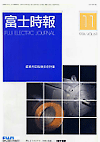FUJI ELECTRIC JOURNAL Vol.69-No.11 (Nov/1996)
 |
Rotating Machine Technology of Industrial-Use |
Recent Situation of Rotating Machine Technologies
Toshio Inoue
Electrical and mechanical technologies for rotating machines have steadily progressed. Mainly by improvement in material and analysis technologies, the products have been reduced in size and weight while meeting the market needs under diversification and sophistication. This paper describes the current analysis technology, citing electromagnetic field analysis for minimizing permanent magnet motor cogging torque and ventilation flow analysis for optimizing the shape of Ring Blower casings, the transition of insulation technology in which the insulation class improved every 20 years up to the present F-class totally vacuum impregnation system, and recent diagnosis technologies.
Developments and Trends of Industrial-Use Rotating Machines
Shoichi Ujima, Etsuhiro Senda, Chiaki Moriguchi
Fuji Electric has developed new rotating machines of various capacities to meet market needs. Out of large capacity machines, this paper cites the low-speed synchronous motor in which the variety of production control points is reduced by the VRP (variety reduction program) method; out of medium ones, the new R90 series in which output is increased up to 2,500kW by rib cooling; and out of small ones, the induction motor in which cooling characteristics is improved and machining is reduced by aluminum die-casting. The paper also describes up-to-date technical trends such as direct coil winding on divided cores to raise the winding volume rate.
A Self-Starting Four-Pole Cylindrical Synchronous Motor
Kenji Endo, Shoji Satoh, Kikuo Fukuchi
A self starting synchronous motor with starting windings on the cylindrical laminated core can have average and pulsating torque in starting freely set by controlling their arrangement. On the basis of the analysis method with precision verified using a 500-kW prototype machine, Fuji Electric has manufactured and delivered the first 20 MW machine for practical use. This paper outlines problems and countermeasures in applying the cylindrical type as well as the result of the 20MW machine test in which expected starting characteristics were obtained.
New F-resin/G Insulation System for Medium High-Voltage Motors
Hirotoshi Sasaki, Seiichi Inoue, Yasunori Kawaji
High-voltage rotating machines are used in various fields of industry and their is intense demand for freedom from maintenance to reduce labor. To meet this market requirement, Fuji Electric has developed a new F-resin/G insulation system for medium high-voltage rotating machines on the basis of its insulation know-how. This insulation system is completely changed in impregnation resin and mica tapes and positively uses sub-materials suitable for resin impregnation, resulting in superior heat resistance and insulating characteristics. This paper outlines the new insulation system.
Linear Door Systems
Hiroshi Harie, Akio Inage, Kenji Yada
Under the development concept of "Sliding doors soft to passengers,"Fuji Electric has developed a linear door system for driving the sliding doors of cars. This system has many superior functions such as the varied thrust operating patterns for the safety of the passengers and quick door operation in the rush hours. In addition, it has monitoring and self-diagnostic functions to simplify maintenance. This paper describes the functions, configuration, and construction of the linear door system.
Accurately Controlled Routine-Operated Seismic Source System
Yoshinori Koganei, Hitoshi Maruo, Hideaki Nagahama
Recently, we have had big earthquakes in many places in the world, and in Japan, a great deal of damage was done by the Hansin earthquake in January 1995. Under the circumstances, the necessity of researches on earthquake forecasting is growing stronger. Fuji Electric has fabricated a practical experiment level, accurately controlled routine-operated seismic source system invented by Professor Kumazawa, the Department of Science, Nagoya University. This system can steadily radiates single frequency seismic waves into ground by rotating the eccentric mass under precise frequency control. This paper outlines the system.
Geared Motors
Masataka Ojika, Soichi Kosaka
Geared motors are increasingly used in household equipment in addition to conventional factory automation and industrial equipment. Uses for household equipment demand small size, light weight, low noise, and short time for production more intensely than those for general industry. To meet the situation, the uniform load (MGC) series reduced in size, weight, and time for production was developed and put on the market. Also developed was the series with a noise level lowered by 10 dB or more for exclusive use in multi-level parking equipment. This paper describes an outline of their features.
Noise Analysis of Ring Blower
Shigeaki Ota, Motoi Miyawaki
The Ring Blowers with advantages of small size, light weight and high air pressure are widely used in industrial machines. To meet the market requirement for low noise, Fuji Electric has continued to develop low-noise Ring Blowers. This paper describes analysis technologies for noise reduction, such as vibration-radiant sound analysis using the boundary element method and sound analysis using finite element method, focusing on application examples.
Electromagnetic Noise in Induction Motors due to PWM Inverters
Yoshihiko Okuyama, Hiroshi Ohsawa
When a squirrel-cage induction motor is driven by a PWM inverter, electromagnetic noise different from the one during commercial power source drive is experienced. This is due to sideband wave (time harmonic) voltage included in PWM inverter output voltage. This paper describes the mechanism of electromagnetic noise generation in commercial source drive, then electromagnetic force considering the sideband frequency and voltage content, and the mechanism of electromagnetic noise generation in PWM inverter drive. It also refers the sideband frequency and voltage content due to operate time in control.
Analysis of Surge Voltage due to PWM Inverters
Yoshihiko Okuyama, Hideki Fujii
When a motor is driven by a PWM inverter, the inverter output voltage of the chopping DC voltage causes reflections between the motor and inverter terminals and overvoltage (inverter surge) is impressed on the motor. This paper describes the analysis of the mechanism of inverter surge generation and surge behavior. A maximum voltage of two times the DC voltage of the inverter DC link circuit is impressed on the motor terminals; the paper refers to voltage attenuation in the cable and surge voltage distribution in the motor windings.

